NEWPORT FOREST
CLOSED CONSERVATION AREA
(updated January 2012)
Newport Forest is a 115-acre (46.5 ha) conservation area within a 200-acre (61 ha) block of riverine forest on the south bank of the Thames River in SW Ontario a few kilometres SW of Wardsville. At latitude 42-37-50N it is in Canada's most southerly area, just north of Lake Erie.
Newport Forest is a "closed conservation area", meaning that permission is required to enter the property. It is not open to the public and all trespassing, including hunting, fishing and walking in Newport Forest proper, as well as the surrounding forested block, are forbidden by the owners, the Thames-Talbot Land Trust.
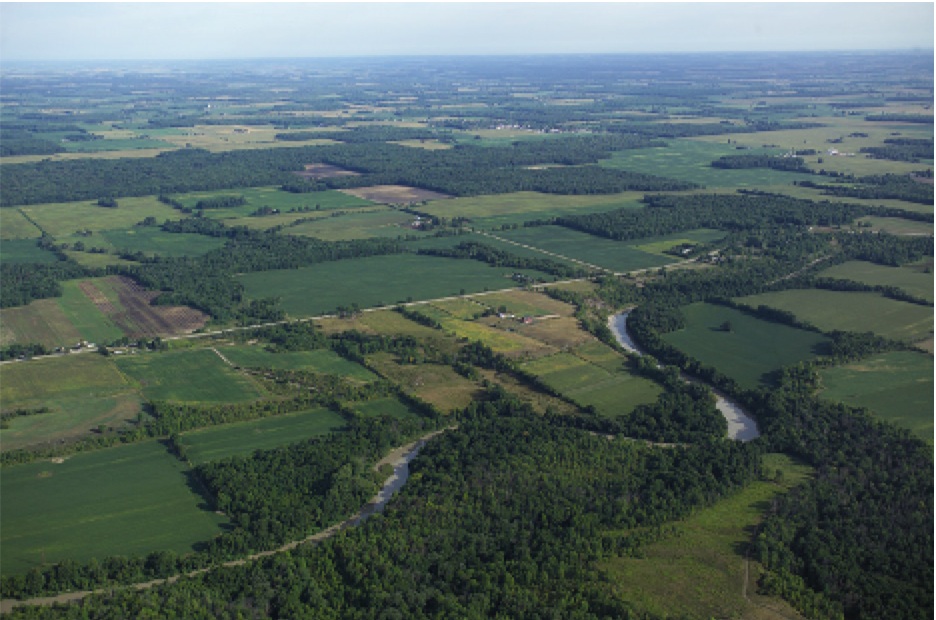 Newport Forest - looking north toward Skunk's Misery image credit: TTLT Newport Forest - looking north toward Skunk's Misery image credit: TTLT |
Newport Forest appears in the foreground of the image above. In the distance, one can see several large tracts of wooded land. Collectively, these wooded tracts, along with Newport forest, are known as the Skunk’s Misery Forest Complex. The dream is to create a National Forest someday, with these tracts as nuclei for a massive reforestation project.
Along the northwest boundary of Newport Forest the Thames River forms a large point bar, covered by a deciduous floodplain forest (or northern riverine forest ecotype [2]), grading rather abruptly into a Beech-maple forest at the foot of a long hill called the Hogsback. The open areas of Newport Forest make up approximately 25 % of the area and are former pastures, now oldfield with extensive wet areas in the late winter. At that time vernal ponds in the Blind Creek Forest (south of the Hogsback) recharge, then begin to shrink, even as the amphibian larvae mature. The ponds often dry out by July.
The aerial photo below, taken in late winter, shows physical features of the property more clearly. The Thames River winds through the northwest corner of
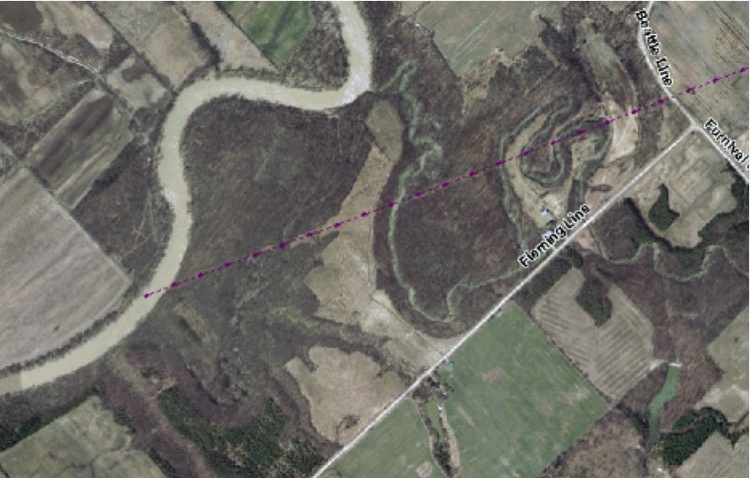 |
the image, forming the point bar mentioned earlier. Fleming Creek enters the property from the northeast and exits to the northeast after completing a half-circle through Newport Forest. Its floodplain currently hosts a developing forest that has now almost completed the transition from thorn forest to primary canopy forest. If one examines the area where Fleming Creek enters the Thames, one will notice what appears to be a continuation of Fleming Creek behind the Hogsback. At one time Fleming Creek did, indeed, follow this course but the Thames, cutting bank to the south, intercepted the creek about 200 (or fewer) years ago. This left the old creek bed, now called “Blind Creek” (local name), high and dry. Today the “creek” has developed into a chain of vernal ponds.
Fleming Creek is one of just three continuously running creeks that enter the Thames from the forks near London, Ontario, down to Lake St Clair.
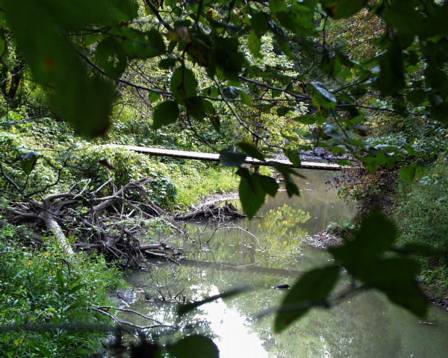 Fleming Creek with pipe-bridge in place |
For the purpose of locating various features and finds within the property, we have defined a set of “locales” that consist of largely uniform vegetation types. Some locales, such as the “Riverside Forest,” are rather large. Others, like the “Sandbar” are rather small. Included below are views of the Riverside Forest interior, as well as the Sandbar locale.
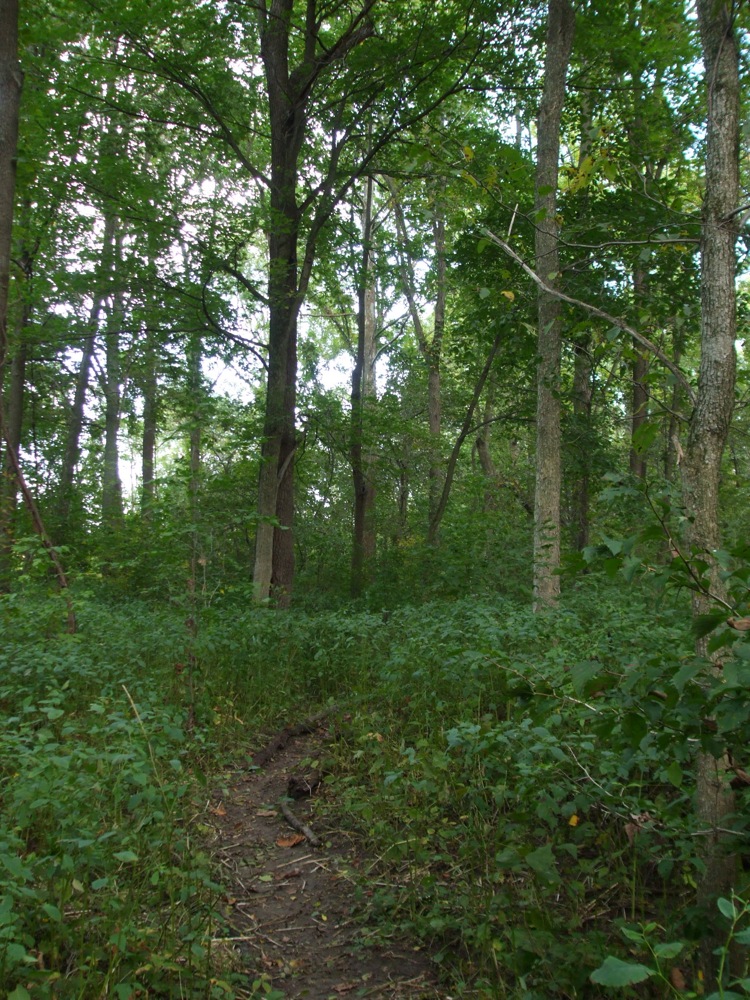 This part of the RSF has about a half acre of Virginia Bluebells in the spring This part of the RSF has about a half acre of Virginia Bluebells in the spring |
The Sandbar has emerged only in the last decade, as very high winter floods deposit tons of sand just inland from the shore. Loaded with nutrients, the sand and silt support a riot of vegetation, much of it viney.
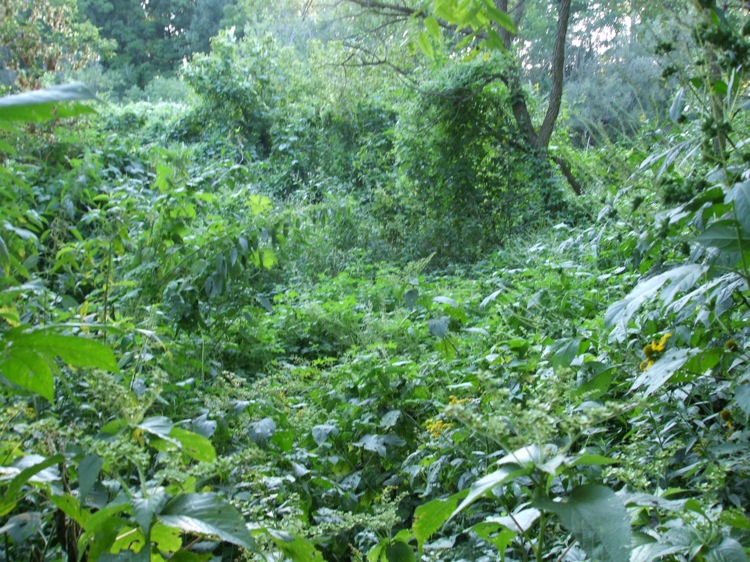 Beneath the greenery is a vast and ever-growing pile of sand Beneath the greenery is a vast and ever-growing pile of sand |
The Sand Bar is covered with Stinging Nettle, Giant Ragweed, and vines of False Buckwheat, Virgin’s Bower, and Wild Cucumber. In the immediate area one finds many Box Elders, Slippery Elm, Hackberry, White Elm, Silver Maple, and one gigantic Blue Ash. Pawpaws have been planted here and appear to be taking.
The Oldfield meadows mentioned earlier are typified by the Upper Meadow, seen below in mid-fall when some of the trees have begun to turn colour. In this scene various species of Aster dominate the vegetation, with goldenrod playing a secondary role. In the Lower Meadow, meanwhile, the situation is reversed, with goldenrod dominant and Asters relatively minor.
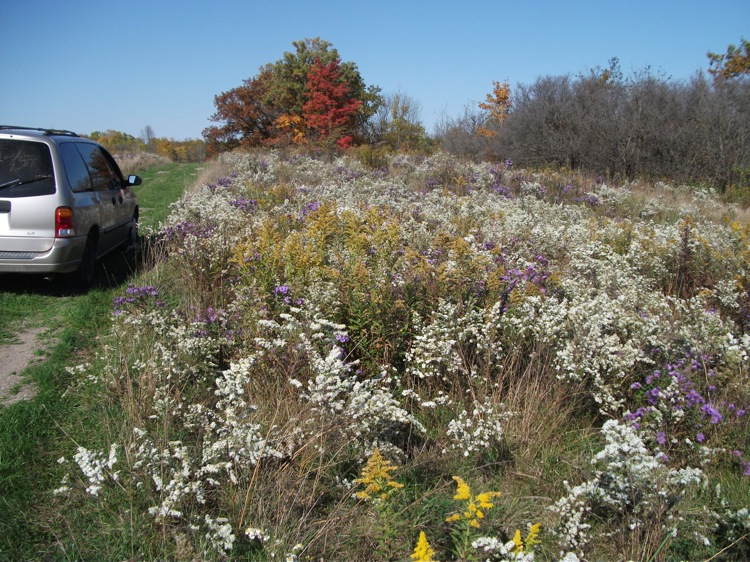 Upper Meadow (UM) is bedecked with asters and goldenrods Upper Meadow (UM) is bedecked with asters and goldenrods |
In the image above one can see the access road, a former farm track that leads down to the Lower Meadow. Just to the right of the image the Upper Meadow comes to an abrupt edge at the Fleming Creek Bluffs, a steep, partially wooded system of cliffs that are about 80’ high in relation to the creek.
In the Lower Meadow, we have implemented a regeneration project involving the planting of approximately 400 saplings in a one-hectare zone adjacent to an onsite trailer (for the use of the Dewdneys and their guests). The species thus planted represent two separate planting policies. Early on, we decided to plant a “demonstration forest” with a great variety of native speciss. After the TTLT handover, we changed the policy to concentrate on native species generally found in the area. At the same time we have been removing all thorn trees and thinning many (native) successional saplings such as Black Walnut and White Ash, in order to make room. The two strategies dominating the project are a) to leapfrog the successional stages and b) to plant about twice as thickly as is necessary. The first strategy is somewhat new to us and we do not know what sort of success to expect. The second strategy puts the onus on the trees best suited to survive the coming light competition as a canopy develops. Thanks to intensive watering, when needed, we have a rather stellar survival rate of something like 75%. At this writing, about 20% of the planted trees are over our heads, another 20% visible above the veg, and the remainder, like the young oak in the image below, too small to be seen over the goldenrod.
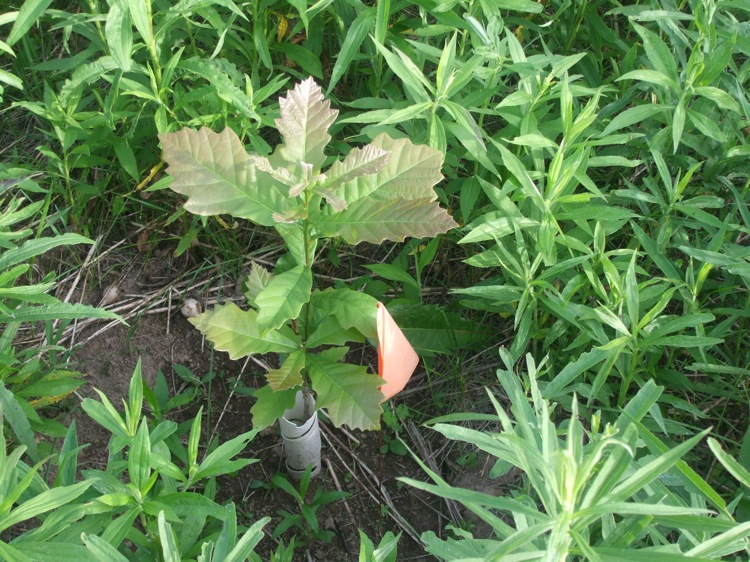 Young 2nd yr Red Oak has tree gard and watering flag, drip can to be added Young 2nd yr Red Oak has tree gard and watering flag, drip can to be added |
Newport Forest was selectively logged over the twentieth century, with many maples and walnuts sold to local sawmills for furniture and gunstocks -- or veneer. In the areas most heavily logged, a great many Bitternut Hickories had sprung up, most mature by the turn of this century. In 2005 Newport Forest was visited by a nasty little beetle named the Scolytus Hickory Borer that simply devastated the Bitternut population, about 100 mature trees. They were all down within two years of the infestation starting. This has been a boon to the mycologists, but a real bother for trail maintenance, as logs across trails became a constant nuisance.
A two-km system of trails gives access to most locales. Use of the trails has prevented much trampling that would otherwise have resulted from the survey work currently under way. The only other infrastructure is a trailer currently parked above the Fleming Creek Bluffs in the Lower Meadow, a collapsible bridge over Fleming Creek (temporarily removed), and several rest benches set at strategic locations along the trail.
*The northern riverine forest ecotype typifies vegetation along the Ohio and Mississippi Rivers and grades into southern riverine forest in Louisiana.
Physical History and Geography
Around 200 years ago, this part of Ontario was fully forested except for small open areas of prairie. Within the Eastern Deciduous Forest (EDF) the forest type was primarily Beech-maple with more southern elements typical of the mixed mesophytic forest of the Ohio Valley. Woody species thus included some concentrations of unusual exotics such as Tulip Tree, Sassafras, Black Gum, Cucumber Magnolia, and others, usually growing on sandy or other well-drained soil. Fauna included not only animals typical of the Beech-maple zone, but exotics such as Southern Flying Squirrel, Badger, Blue Racer, Cottonmouth, Fowler's Toad, and others. A few of the exotic elements remain in the Skunk's Misery Complex, including Newport Forest.
Approximately 14,000 years BP a seam opened between the Huron and Erie lobes of the vast Laurentide ice sheet that covered North America from the arctic down to what is now the US midwest. Meltwater from the lobes formed a vast river up to two km wide in places, the proto-Thames. This ancient river entered Lake Whittlesey (later to shrink to present-day Lake Erie) in the vicinity of what is now the Moraviantown First Nation (Delaware) near Thamesville, Ontario. Thus the land emerging from beneath the ice sheets along the proto-Thames is the most ancient post-glacial terrain in Canada (except for coastal nunutaks).
Anyone traveling down the Thames River will see why the early French explorers called it "La Tranche." Along extensive stretches it has relatively high, steep banks of heavy, sandy clay. Behind the banks, which form a system of primary terraces, one will occasionally find secondary terraces, some of them carved by the present river, others the remnant shoreline of a more ancient river. Behind these are the largest terraces, only sometimes glimpsed in the distance, but occasionally nudged by the present river. These are the most ancient shorelines. The physical relief of Newport Forest was carved during the post-glacial period, when Fleming Creek, which drained the Erie Lobe (then retreating to the southeast), flowed behind the terrace remnant now called the Hogsback.
A bend in the Thames River forms the 850-metre northern boundary of Newport Forest. The Hogsback has a north/south alignment, with its north end forming a massive bluff that forces the river to flow west for a few hundred metres. Subject to periodic flooding, the river is a major source of fine sand/silt for the massive point bar that has formed downstream of the bluff and that makes up most of the river bend. The same materials have been deposited in the three major riverine forests on the property.
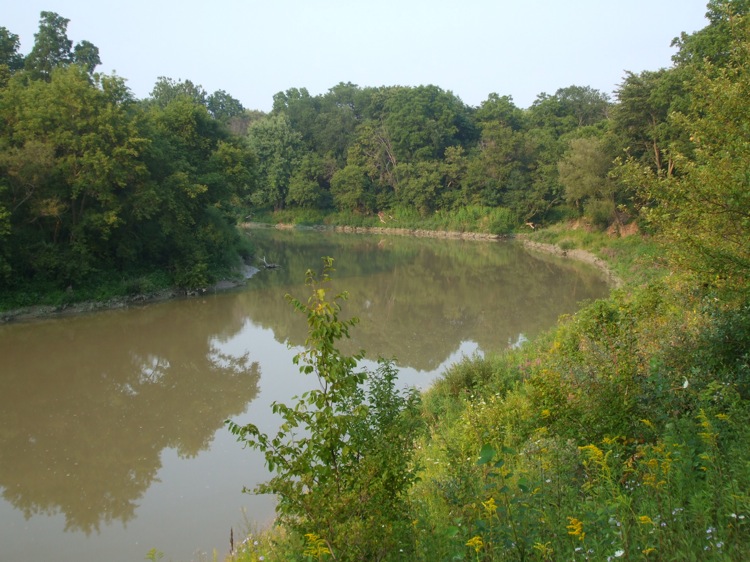 Thames River looking upstream from the River Bluffs |
If there is one single factor that drives both the physical and biological ecology of Newport Forest, it would be the winter floods that are sometimes so massive as to be downright scary. When the Thames floods, for example, it backs up into Fleming Creek, producing a large lake that half-immerses the Fleming Creek Forest.
The following image, taken after one of the winter floods, shows a typical flood line formed by hanging ice that is about 60 feet below the camera location. The ice formed about 25 feet above the creek.
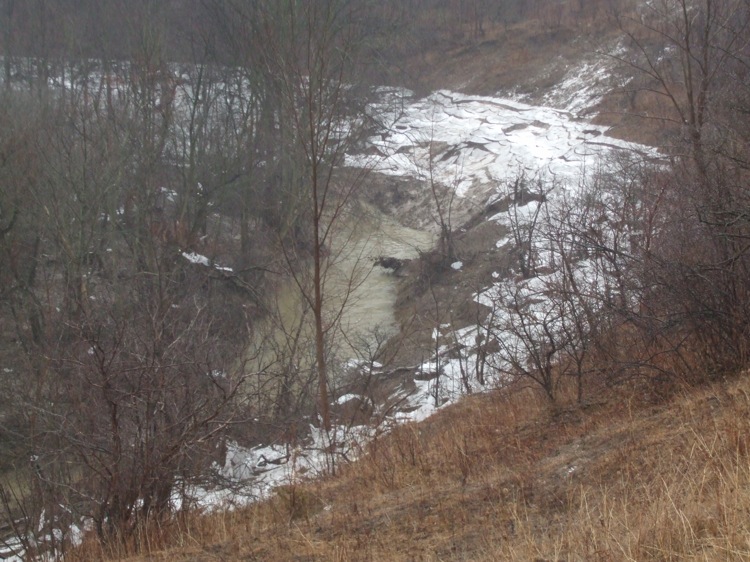 Hanging ice remains from 25’ high flood |
When the flood crests for a day or two, the water is usually nonmoving and readily forms ice. Even as the water slowly subsides, the ice continues to thicken. By the time it reaches sapling height, it may be 3-4” thick and extremely heavy. When these giant ice-cakes melt in the early spring, you may see the damage everywhere in the form of crushed saplings, and even young trees splintered, with missing limbs. The floodplain is a rigorous environment for young trees!
Vegetation and Wildlife
Perhaps the single most important project to be carried out at Newport Forest has been the all-taxa biological inventory (ATBI) project that recently arrived at the 1700 species mark. The inventory spans five kingdoms, including eubacteria. At the time of this writing, the species logged so far break down as follows:
| Kingdom | No. of species |
| Eubacteria (incl. cyanobacteria) | 22 |
| Protista | 194 |
| Animalia | 985 |
| Plantae | 481 |
| Fungi & Lichens | 223 |
| Total | 1903 |
The total handily exceeds the earlier numbers (approx. 1200) accumulated by our three-year pilot project in the A’Nowaghi Forest Ponds near London, Ontario (Dewdney, P. & A. K. 1998). The larger current number does not mean that Newport Forest is richer in species than A’Nowaghi Forest Ponds, but only that we have spent more time on inventory work at Newport than at A’Nowaghi. If we should live to a ripe old age, we might get as high as 2500 species, most of them insects! Assisting in the ATBI project there have been many biologists and naturalists to whom proper credit ought to be given:
| Muriel Andreae | Conservation Officer & naturalist |
| Daniel Bickel | Entomologist (ANM) |
| Jane Bowles | Botanist and vegetation ecologist (UWO) |
| Michelle Carnerie | Bird expert |
| Stan Caveney | Entomologist (UWO) |
| Donald Craig | Conservation Officer & naturalist |
| Steve Marshall | Entomology (U Guelph) |
| Dave Martin | Bird expert |
| Mike Oldham | Botanist and Herpetologist (NHIC) |
| James Phipps | Botanist (UWO) |
| George Prieksaitis | Naturalist |
| Jeff Skevington | Entomologist |
| Dorothy Tiedje | Botanist and birder |
| Greg Thorn | Mycologist (UWO) |
| David Wake | Bird expert |
| Winnie Wake | Bird expert |
| Andrew Young | Entomologist (U Guelph) |
| Nina Zitani | Entomologist (UWO) |
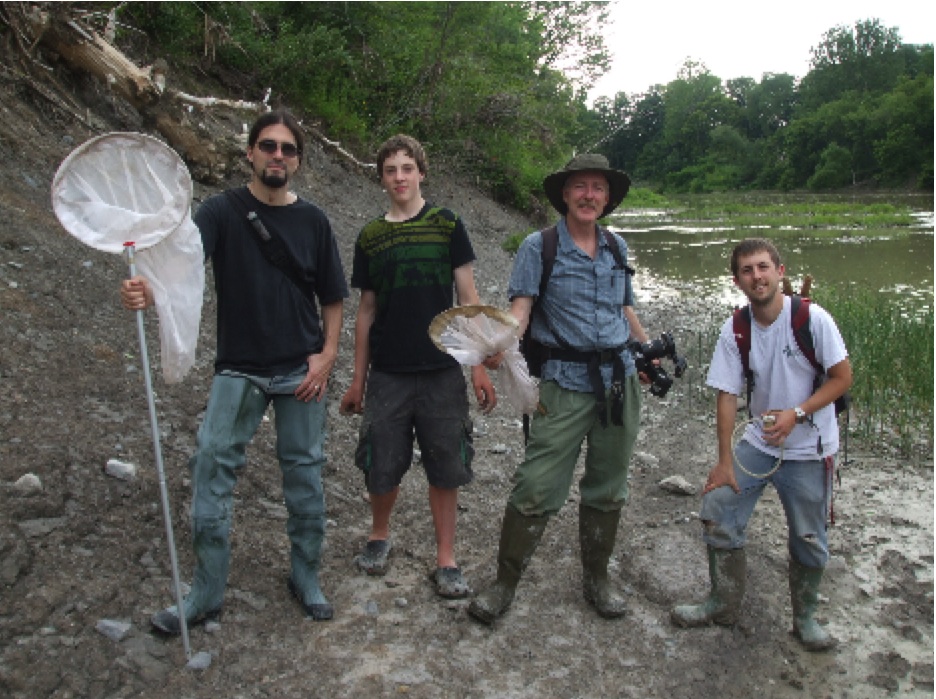 Steve Marshall (2nd from right) of the University of Guelph collects Steve Marshall (2nd from right) of the University of Guelph collects insects by the river with son and two grad students July 30 ‘09. |
Since anyone who is curious about just what we have found on the property may readily access the pdf file referred to above, we will close this section with a review of some of the less common species encountered in the course of the inventory.
Plant Life
Blue Ash is a provincially uncommon tree, yet rather common on the property --including a meter-wide giant by the river’s edge. There are two Eastern Flowering Dogwood trees known on the property, one young, the other old. A single Sassafras sapling was spotted growing under one of the hydro towers and moved to a better location. Tulip Trees were known historically to grow along Fleming Creek off-property. We have reintroduced them in the regeneration project. Oddly enough, they have the best survival rate of any of the planted trees! (100%)
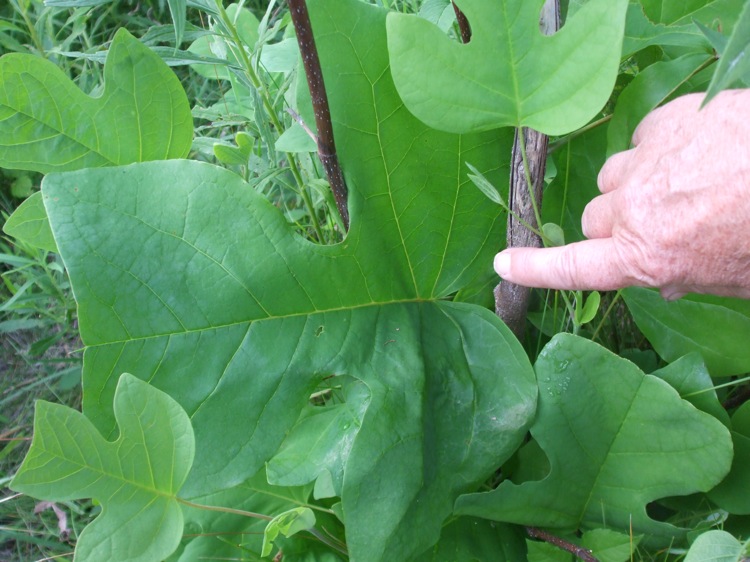 Leaves on very young trees can be enormous, as with this Tulip Tree Leaves on very young trees can be enormous, as with this Tulip Tree |
A somewhat uncommon tree regionally, the Black Maple is quite common on the property, about as abundant as Sugar Maple. At the moment, our inventory list contains 27 canopy species, 25 understorey species, 21 species in the shrub layer, and 8 species of woody vines.
Herbaceous plants have proved a treasure trove of species that are uncommon outside the Thames Valley. Among these are Virginia Bluebells, a beautiful spring ephemeral, Cup Plants growing by the river, Wingstem very common in the Blind Creek Forest, Jerusalem Artichoke and Tall Sunflower occasional in the Lower Meadow. Up on the Hogsback delicate tendrils of False Mermaid wind through the leaf litter and on the Hogsback slopes we find several patches of Harbinger of Spring, a rare plant. In the Riverside Forest Pale Touch-me-not plants mingle with their spotted cousins. Here and there we have found Seneca Snakeroot, Dutchman’s Britches, Cream Violets, White-flowered Trout Lilies, and Blue Cohosh. Two of our sedges, Carey’s and Emory’s, turn out to be regionally rare.
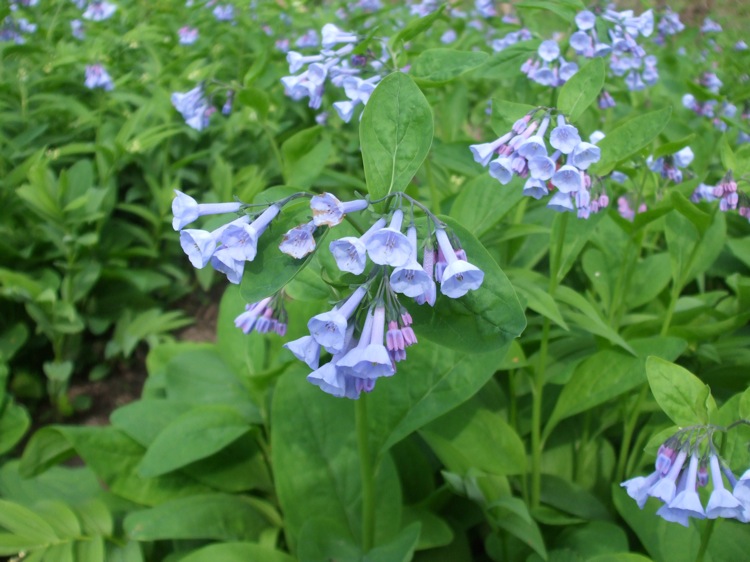 Newport Forest is famous for its Spring Bluebell Walk for invited groups Newport Forest is famous for its Spring Bluebell Walk for invited groups |
As indicated in the earlier section on property locales, some herbaceous plants such as asters and goldenrods are very common in open areas. In the wooded areas, we see Jewelweed, Wood Nettle and Stinging Nettle, Tall Meadow Rue, Virginia Smartweed, among others, along with that perennial favorite, Garlic Mustard! We have pulled and bagged about half a ton of Garlic Mustard but have given up trying to control it. Interestingly, some plants have actually crowded the GM out of areas it formerly dominated. Virginia Bluebells, for example! Other invasives include Multiflora Rose (coming out, one gigantic bush after another), Common Buckthorn (very few stems) and Autumn Olive (about 50 small trees to go).
Having found some 466 species of plants on the property so far (with thanks to Jane Bowles and others for the difficult ones), it is now fairly safe to say that our plant list is perhaps 80% “complete.” It is also safe to say that the most speciose families would probably be the following, although not necessarily in this order (based on current species counts):
| Family | No. of species | Family | No. of species |
| Asteraceae | 69 | Cyperaceae | 46 |
| Rosaceae | 35 | Poaceae | 34 |
| Ranunculaceae | 15 | Liliaceae | 15 |
| Apiaceae | 13 | Polygonaceae | 10 |
At the present level of the plant inventory, new species are getting harder and harder to find. But the upside is that when we do find one, there’s an unbelievable rush, especially when the plant is attractive. Last spring, for example, we found our first Groundnut, a legume with beautiful pink and white flowers growing at the River landing.
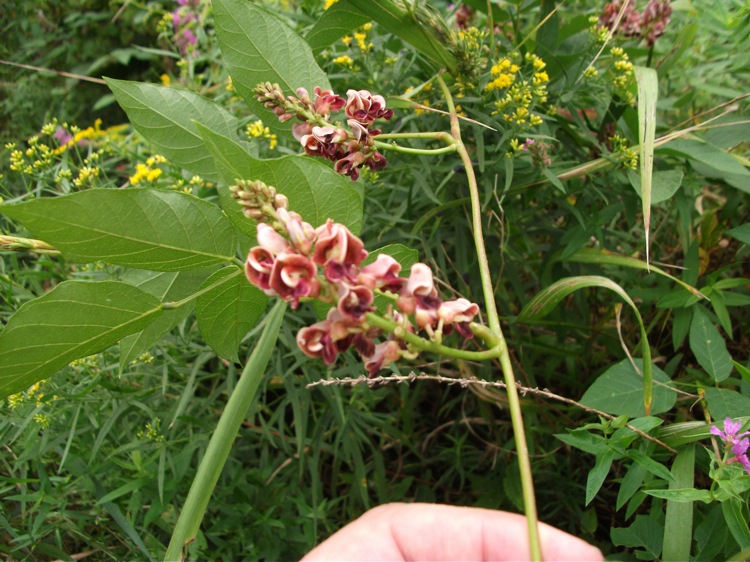 The Groundnut has an edible tuber that natives used as a food source The Groundnut has an edible tuber that natives used as a food source |
Animal Life
The mammal list for Newport Forest contains nothing exotic except, possibly the Southern Flying Squirrel, relatively common on the property and living in large numbers in the barn on a neighbouring property. Rare on the property are possums and skunks, which are regionally common! One reason for their relative rarity may have something to do with the winter (and occasional summer) floods. Burrowing animals better be on high ground! Three other species of squirrel inhabit Newport Forest besides the flying squirrels: The Red Squirrel, the Eastern Chipmunk, and the Eastern Gray Squirrel. We have yet to discover a Mole on the property, although Shrews (Short-tailed and Masked) are present. The upper reaches of the property have heavy clay soil and the lower reaches are not that much easier to dig.
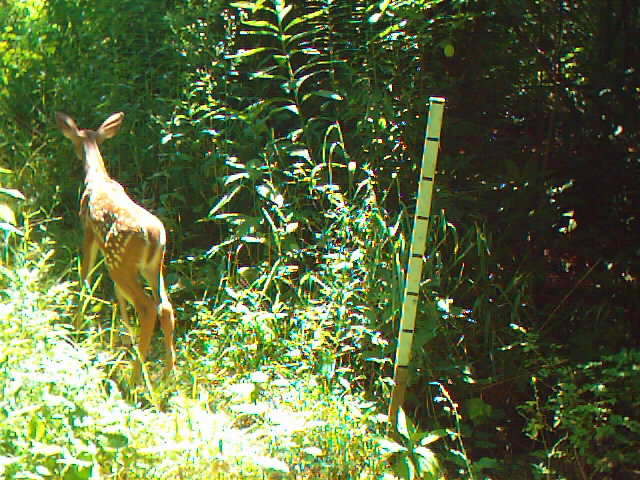 Fawn caught in trail cam leaves Blind Creek Forest for the Lower Meadow Fawn caught in trail cam leaves Blind Creek Forest for the Lower Meadow |
The deer population fluctuates as individuals pass into the property and out if it. The next property to the west has been made into an informal conservation property by its owner. The many thickly-planted pines filling the centre of that forest make an ideal winter yarding area. We have occasionally spotted bucks, does and fawns on the property, frequently “seeing” them on our game camera, as above.
Coyotes are common in the area and we often hear their choruses at night. We have photographed and measured tracks of a Gray Wolf (4” wide paws) that strayed into the area several years go, as well as tracks of a Bobcat or young cougar (3” wide paws) on the clay beach by the river. Cougars have been sighted several times in the area, including at least one melanistic individual. The Ontario Ministry of Natural Resources which used to deny the existence of cougars in Ontario, now regards them as anative animal. Cougar sightings, even if one subtracts the ones by questionable witnesses, far outnumber Bobcat sightings in southern Ontario, leading one to believe that the big cats are more common than the smaller ones! Feral (domestic) cats show up on the game camera and we find their tracks in the winter.
Raccoons are common on the property, as everywhere else. We were astonished and somewhat disheartened to watch by flashlight as one of our night prowlers nabbed a flying squirrel off the bird-feeding tray, took it in its mouth and climbed down the tree to dine elsewhere.
Beavers are present in the area, as witness gnawed branch logs that come down the creek. We have also seen a stand of poplars about 5 miles down the river completely decimated by beavers. Their smaller cousin, the Muskrat, has been sighted crossing the river or creek on many occasions.
Bird Life
The Newport Forest bird list now contains over 140 species, some yearlong residents, others migratory, and still others occasional visitors. The yearlong residents include the usual suspects for this area: American Crow, Black-capped Chickadee, Blue Jay, Canada Goose, Downy and Hairy Woodpeckers, Great Blue Heron, Mallard, Northern Cardinal, Pileated Woodpecker, Red-bellied Woodpecker, Tufted Titmouse, White-breasted Nuthatch, and Wild Turkey. The overwintering of the heron is not always a given, but frequent enough to be noticeable. Of the foregoing birds, only the Tufted Titmouse is rare, in fact “of concern” in Ontario. .
At the other end of the spectrum we have those birds that are rarely here, the occasional visitors and strays. Our classic example of this is the lone sighting by Pat of a Redheaded Woodpecker. At one time they were more common than Redbellied Woodpeckers, now a dominant Newport Woodpecker. A few warbler species were only seen once, including the Blackpoll, Black-throated Green, Tennessee, Orange-crowned, Wilson’s and Palm Warblers. Other occasionals include the Black-billed Cuckoo, Horned Lark, Northern Shrike, and the Willow Flycatcher.
The birding season begins with an overflight or two of Tundra Swans in the early spring. Over succeeding months, many of our favorite birds arrive, from the Common Grackle to the Rose-breasted Grosbeak, Northern Oriole and Orchard Oriole. Pat always delights in the Indigo Buntings that perch by the old snag near the trailer, while Kee delights in the song of the “Rain Crow,’ as below.
“Khoo Khooo Khooo” ... “Kwa-ka-ka-k-k” 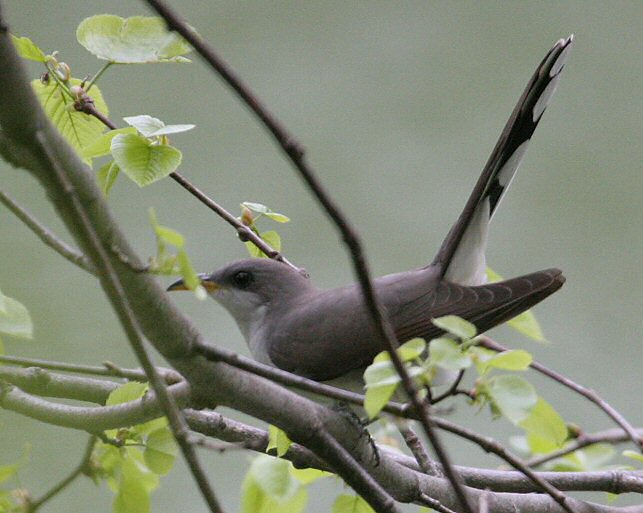 The Yellow-billed Cuckoo makes the raincall in humid weather The Yellow-billed Cuckoo makes the raincall in humid weather |
By groups, the largest families are the sparrows (Fringilidae) with 20 species, warblers (Parulidae) with 19 species, thrushes and kinglets (Musciapidae) with 9 species, woodpeckers (Picidae), the larks and swallows (Hirundinae), and the blackbirds and orioles (Icteridae), each with 7 species. Then come the vireos (Vireonidae) and the phoebes and flycatchers (Tyrannidae), each with 5 species.
Because there are so many species and their characters are so various, generalizations are hard to come by. But various interesting groups stand out. For example, the large number of woodpeckers on the property may reflect to some extent the many dead Bitternuts, most over but some still standing. We often encounter such standing trees with large “digs” excavated by Pileated Woodpeckers.
Game birds run the gamut from common (Wild Turkey) to middling (American Woodcock) to rare (Ruffed Grouse). Even in the 11 years that we have been visiting Newport Forest, Ruffed Grouse flushes have declined from several a year to none over the last six years! This is a cause for concern.
Birds of Prey include the owls (only three species) to the hawks and eagles. Flights of Bald Eagles along the river are a fairly common sight, with several every year. We have logged 10 species of hawk, the Redtailed Hawk being the most common, with occasional predatory visits by Cooper’s and Sharp-shinned Hawks. We often see Northern Harriers hunting over the open meadow areas, along with occasional American Kestrels.
If we had more observers expert in ducks, our list would undoubtedly expand in this area. Both the Mallard and the Wood Duck are common. We see both species of Merganser from time to time, as well as rare sightings of Buffleheads and Teals. However, one may suspect twice that many Anatids actually show up along the river. Good Seagull observers would also expand the list of Larids. Other river birds that we commonly see down at the beach and bluffs area include the Spotted Sandpiper, Cedar Waxwing, Bank Swallow, and of course the Great Blue Heron. Green Herons only appear on occasion.
Up along the Fleming Line the Eastern Bluebird and Tree Swallow take advantage of the many birdboxes installed along the road. A family of Eastern Phoebes nests annually in the porch roof of the Hurdle house, just across the road from the property gate. We have watched the mother and young hawking insects down at the creek rapids.
Fish in River & Creek
As might be expected the Thames River is very rich in fish species. We have recorded 21 of these species and have noted another 8 species (not included in the count) claimed by fishers. One of our most memorable piscine adventures was to stand, one fine spring day, on the bank of the clay beach by the river with Darren Jacobs, a First Nations Delaware who showed us the spring migration of the Longnose Gar. They came, one after another, like a train, following the bank just below the water’s surface, nose to tail. We’ve held fishing derbys, set out minnow traps, and gone kick-sampling in the creek and river rapids. Our fish list is still half the size of our wish list.
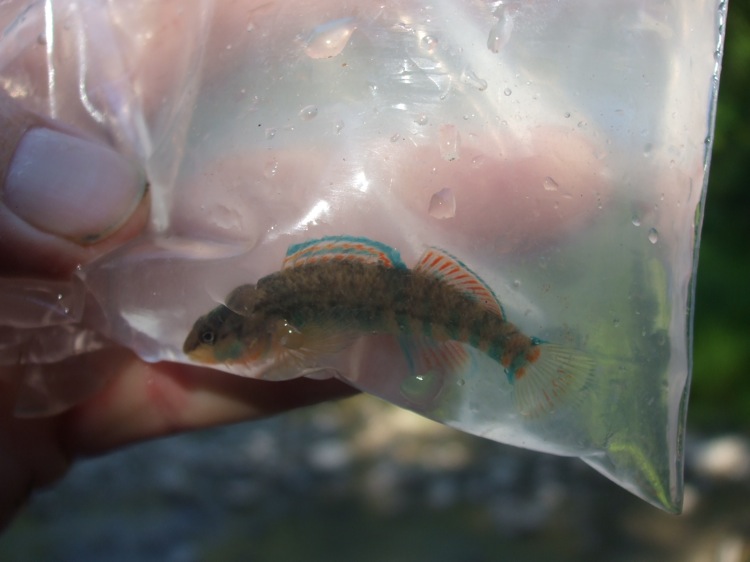 Rainbow Darter found in the Lower Rapids of Fleming Creek Rainbow Darter found in the Lower Rapids of Fleming Creek |
Some unexpected treasures have showed up. From the minnow trap we once extracted a silvery minnow that looked like it might be an Emerald Shiner, a common fish in the area. But how to tell for sure? Out came the magnifying glass to reveal a row of beautiful emeralds embedded in the fish’s lateral line. Another treasure was found in the creek rapids, a darter with rainbow markings, as in the image above. Another surprise came when we hauled a large box-net from the creek, set out a day earlier by Darren. What were two Northern Pike doing in the creek? But there they were!
So far the largest order of fish is Perciformes, with 4 species of bass, 4 darters, and the Freshwater Drum. The next most common order, the Cypriniformes, includes suckers, redhorses and other common species such as the Brassy Minnow, Bluntnose Minnow, and Hornyhead Chub. So far also, we only have one species of catfish when we should have at least three.
Invertebrates
This group of animals includes the Molluscs, Arthropods, Worms, and other creatures with no spine. We omit microfauna such as Rotifers from this category.
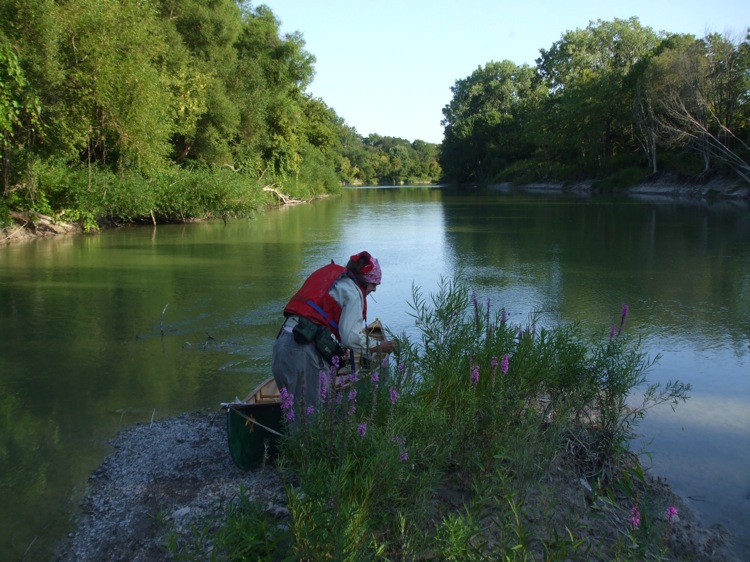 Pat inspects willows growing on Clam Island. Newport Forest starts at Pat inspects willows growing on Clam Island. Newport Forest starts atthe bend downstream in the distance. (That’s a white pen in her mouth.) |
The Mollusc list was greatly expanded when we discovered “Clam Island,” a gravel shoal in the middle of the river about half a kilometere upstream from the clay beach. At times one can visit Clam Island to find the shoals full of clams, perhaps a dozen species in all. At other times, one will find only empty shells littering the course sand, the result of predation by raccoons and shore birds.
We don’t normally go off-property for new species, but in this case we tell ourselves that river biota run more or less continually along its length. Our best find at Clam Island was the rare Round Hickorynut. The most interesting mussel must be the Pocketbook Clam that “fishes” by putting out a “lure” that attracts fish. When they get close enough, the larvae of this clam attach themselves to the fish, ensuring dispersal. We also often find mussels on the clay beach, called, appropriately enough, “Mussel Beach.”
Common names for area mussels reflect human contact with these animals as well as appearance and behaviour. The White and Pink “Heelsplitters” have rather sharp margins. The Purple, Threehorn, and other Wartybacks have warty backs and the Floaters, well, float. We have run across the occasional floater in the middle of the forest after the subsidence of a flood.
The snails, both aquatic and terrestrial, have yielded their secrets thanks to three good reference books. A common sight in the woods is the Amber Snail, frequently seen crawling across leaves. The Eastern Forest Snail (the one we call “The Checkerboard Snail”) is relatively common and both species must compete with that alien invader, the European Striped Snail. Our list of Polygyrid snails has four entries. Other snails are aquatic and include the not-so-common Flat-sided Horn Snail.
Of the many species of slug found in leaf litter and logs in the woods, we have so far identified only a species of Arion. In all we have logged some 38 species of mussels and gastropods.
We will pass over the Annelid worms, Nematodes, Flatworms, and Nematomorphs (hair snakes) in order to move on quickly to the most abundant group of animals by far on site.
Arthropods
Our smaller animals outnumber larger ones by approximately 100 to one. Arthropods include insects, spiders, crustaceans, centipedes, millipedes and other groups of joint-legged creatures. The two largest Classes of arthropod at Newport Forest are the insects and spiders.
Some 29 species of spider have been logged, the orb weavers being the most speciose (9) so far. The most common orb weavers on site are the Micrathenas. We are constantly ducking their webs over trails during the warms seasons. The Spined Micrathena has a curious abdomen resembling a porcelain teapot. Other genera in the family include Araneus, Argiope, and Neoscona.
An exceptional find was a Carolina Wolf Spider brought to us by the Hurdle’s dog, Snooper. The ID was confirmed by a spider expert at the Toronto Zoological Gardens. As far as he knew, this was the first Canadian record for this impressive creature. Our specimen resembled the image below, black colour being characteristic of recent shedding of exoskeleton.
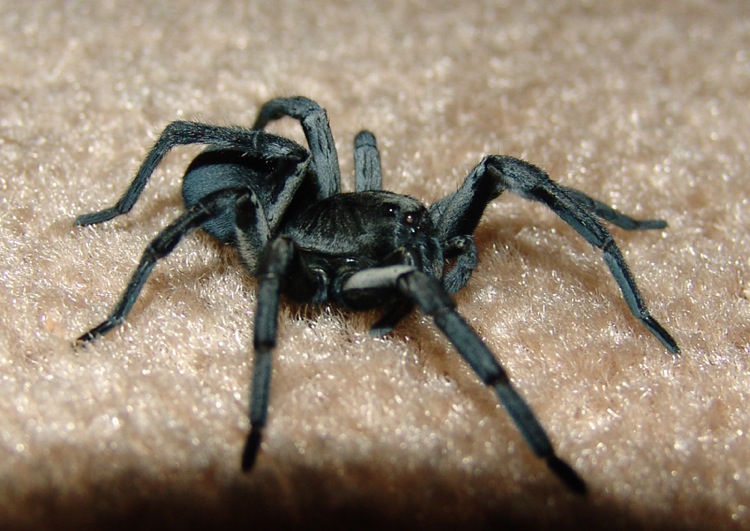 A Canadian first: Rare Carolina Wolf Spider is size of small Tarantula A Canadian first: Rare Carolina Wolf Spider is size of small Tarantula |
Another rarity emerged from the malaise traps that entomologist Nina Zitani set up in the summer of 2005. The Earwig Fly (Merope tuber) was only the 5th or 6th found in Canada, according to our understanding. Overall, we ended up with literally tens of thousands of insects in the malaise bottles and we are still processing them. Thankfully, Steve Marshall and his grad students at the University of Guelph took all the flies (Diptera) off our hands, then added to the favour by sending us about 50 new fly species for the list.
So far we have 517 insects on the ATBI list (with only about 2000 to go). Major groups include the Odonates such as dragonflies and damselflies, often seen cruising over the lower meadow above the creek bluffs, snagging flies out of the air. Common dragonflies include the Green Darner, Widow Skimmer, and Common Whitetail. Among the damselflies, the Ebony Jewelwings are ubiquitous throughout the warm seasons. They love to take up perches beside trails to nab mosquitoes that come out to make us miserable. (The enemy of my enemy is my friend!) By the river we have spotted congregations of the American Rubyspot.
Grasshoppers, katydids and crickets abound at Newport Forest, especially in dry weather. In most years the Katydids begin to sing in July, continuing into the early fall. In some years the overnight chorus has been deafening, while in other years there has been a silence. Our best find to date is the Seaside Grasshopper that clung to the bark of a forest tree next to the river. The most interesting cricket to emerge so far is the Pygmy Mole Cricket that Nina Zitani found at the River Landing. Later Marshall photographed the same insect. We occasionally run into the Northern Walkingstick, a bizarre insect that resembles a twig with legs.
Most of our bugs belong to the Miridae (Plant Bug - 9 species) and Pentatomidae (Stink Bug - 8 species) families. It was a shock to discover a very large and threatening bug in a pond adjacent to the property, the American Toe-biter. This bug is almost two inches long and comes equipped with a nasty-looking beak that it uses to suck juices out of prey. So far 31 species of Homoptera (cicadas, leaf hoppers, spittlebugs, etc.) have shown up.
As for beetles, the dramatic species such as the Russian Leather Beetle, the Pennsylvania Firefly, the Gold-necked Carrion Beetle, the Margined Soldier Beetle, the White-spotted Pine Sawyer, and the Eastern Eyed Click Beetle tend to steal the show. Speaking of drama, one time Pat was resting near the trailer, when she spotted a dead mouse inching over the soil. Wondering by what magic it moved, she found a Sexton Beetle underneath. Once in a better location, the beetle would lay eggs on the carcass.
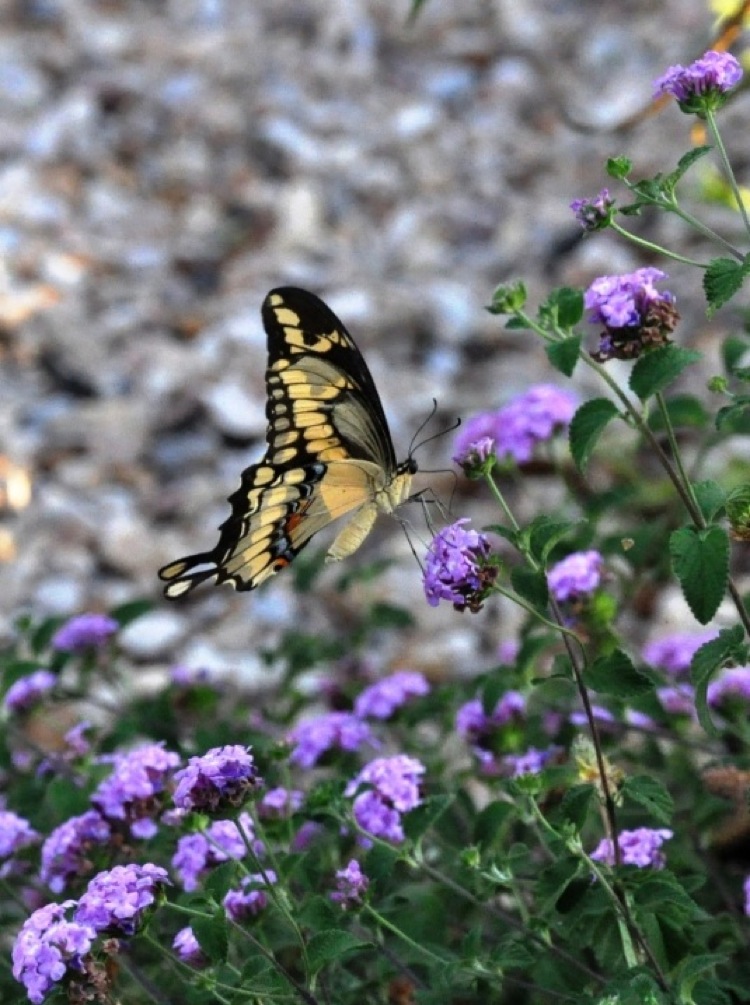 The Giant Swallowtail is a common sight at Newport Forest. credit: Roundrockgarden The Giant Swallowtail is a common sight at Newport Forest. credit: Roundrockgarden |
The annual butterfly count held at Newport Forest every July often tuns up a new species. We are always happy when a Giant Swallowtail shows up to impress the visitors. At this time we have 51 butterflies and skippers on the list, with only a few rarities such as the Baltimore Checkerspot, the Little Yellow, the American Snout Butterfly and the Dun Skipper. However, we have spent much more time on moths than on butterflies, thanks to one of us going through all the Lepidoptera from the malaise trap operation. The 103 moth species found so far break down as follows: Sphingidae (Sphinx moths) 10, Saturniidae (Silk moths) 5, Arctiidae 14, Noctuidae 45, Geometridae (inchworms) 15, Pyralidae 5, along with a dozen minor groups with one or two species each.
Part of the fascination that moths hold for us are the amazing patterns on many moth wings. They are “beyond psychedelic,” so to speak. Visit Tom Murray’s photographic galleries, for example and click on the moth image. A gallery of winged wonders will then appear.
We will leave the flies, wasps, bees and ants for a later installment to this page. At that time we will also inform visitors about what goes on in the microworld of swamp and rapids.
Whose Property is it?
Although we made an “ecological gift” of Newport Forest to the Thames Talbot Land Trust, we’re not sure they’re the real owners. We weren’t even sure that we were the real owners when we had that legal status. Natural treasures like Newport Forest belong to no one and everyone. Our own take is that Newport Forest “belongs” to whomever happens to be there at the moment, valuing it. Because some people value natural land more than others, so to speak, such lands must be protected from further disturbance.
We continue to visit the property as we tend our regeneration forest, log our species, and watch over the land for the TTLT. Since Newport Forest was first acquired, my wife Pat and I have been visiting the place between 55 and 75 times a year. It's a one hour drive from London Ontario, but worth every mile.
The dedication ceremony marked the end of our status a legal owners of the property but to honour the original owners, we invited Native singers and drummers from three different first nations to mark the ceremony.
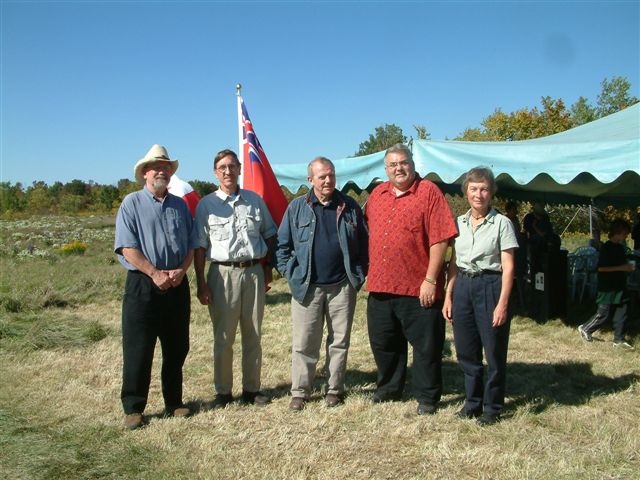 The Property Dedication Ceremony: Graham Warwick (Deputy Mayor of Elgin Co.), Stan Caveney (Thames Talbot Land Trust), Kee Dewdney (Donor), Joe Preston (Federal MP), and Muriel Andreae (TTLT & St Clair CA) The Property Dedication Ceremony: Graham Warwick (Deputy Mayor of Elgin Co.), Stan Caveney (Thames Talbot Land Trust), Kee Dewdney (Donor), Joe Preston (Federal MP), and Muriel Andreae (TTLT & St Clair CA) |
References
[1] Dewdney AK, Dewdney P. 1998. A Three Year Study of A'Nowaghi
Forest Ponds. St. Thomas, ON, Kettle Creek Conservation Authority.
[2] John Kricher. 1988. A Field Guide to Eastern Forests: North America,
The Peterson Field Guide Series # 38, Houghton Mifflin Co., Boston.
Site Visit Reports
With each visit we have made a written report. One copy is printed and kept in binders, the other copy is electronic. Since it acquired the property in 2007, the Thames Talbot Land Trust has also been archiving the reports.
We have now added a fourth archive below. Simply click on the year and month to see all the reports for that month. There are now nearly a thousand reports and archiving is slow work. The webmaster will post up-to-date advisories below so that visitors can see what years and months are currently available.
Webmaster’s archival progress report of posted years and months:
| years | months |
| 2013 | current |
| 2012 | complete |
| 2011 | complete |
| 2010 | complete |
| 2009 | complete |
| 2008 | complete |
| 2007 | complete |
| 2006 | complete |
| 2005 | complete |
| 2004 | complete |
| 2003 | complete |
| 2002 | complete |
| 2001 | complete |
| 2000 | complete |